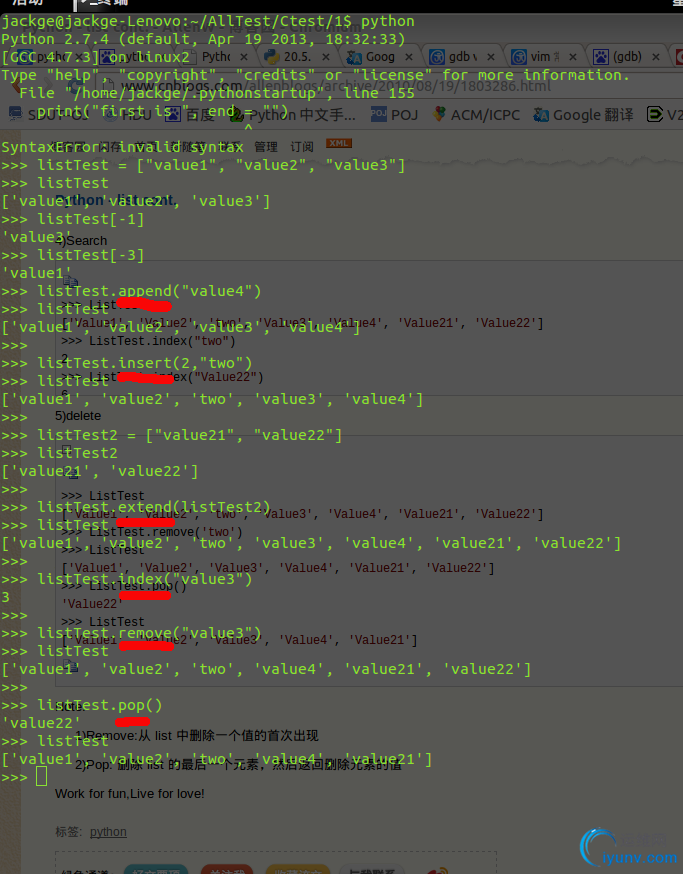|
|
1, 先写一个简单的冒泡排序吧:
#!/usr/bin/env python
# coding=utf-8
#这是一个简单的python冒泡排序
array = [1,2,5,3,6,8,4]
for i in range(len(array)-1,0,-1):
for j in range(0,i):
if array[j]>array[j+1]:
array[j],array[j+1] = array[j+1],array[j]
print array
range函数详解见: http://www.iyunv.com/buro79xxd/archive/2011/05/23/2054493.html
2, Python—— List的几个小方法的使用:
直接看截图吧:

Note:
1)Remove:从 list 中删除一个值的首次出现
2)Pop: 删除 list 的最后一个元素,然后返回删除元素的值
3,Python - split and join:
>>> s="I am fine"
>>> s
'I am fine'
>>> s.split(" ")
['I', 'am', 'fine']
>>> sList=s.split(" ")
>>> sList
['I', 'am', 'fine']
>>> "%".join(sList)
'I%am%fine'
4, Python Class Example :
#!/usr/bin/env python
# coding=utf-8
import os, sys
class Workers:
#This is a class of workers working in the company.
def __init__(self, name, position, email, age, salary):
self.name = name
self.position = position
self.email = email
self.age = age
self.salary =salary
class ITWorkers(Workers):
OS = 'WinNT'
def __init__(self, language, *av):
Workers.__init__(self, *av)
self.language=language
def work(self, n):
if self.position == 'web creator':
w = 'makes web site'
elif self.position == 'server administrator':
w = 'checks the trafic'
elif self.position == 'programmer':
w = 'writes programs'
print '%s %s for %d, hours using %s on %s' % (self. name, w, n, self.language, self.OS)
henley = ITWorkers('PHP', 'Henley', 'web creator', 'henley@livegate.com', 32, 700)
thomas = ITWorkers('Python', 'Thomas', 'server administrator', 'thomas@livegate.com', 37, 900)
gates = ITWorkers('C', 'Gates', 'programmer', 'gates@livegate.com', 42, 1200)
henley.OS = 'Mac'
thomas.OS = 'Linux'
if __name__ == '__main__':
henley.work(8)
thomas.work(7)
gates.work(10)
output:
Henley makes web site for 8, hours using PHP on Mac
Thomas checks the trafic for 7, hours using Python on Linux
Gates writes programs for 10, hours using C on WinNT
5, 一个类似于用户账号管理的程序。程序运行时候,你可以选择是新建账户,或者是登陆已有账号,登陆成功会返回欢迎信息。:
#!/usr/bin/env python
# coding=utf-8
db = {}
def newuser():
prompt = 'login desired: '
while True:
name = raw_input(prompt)
if db.has_key(name):
prompt = 'name taken, try another,please: '
continue
else:
pwd = raw_input("input your password,please: ")
db[name] = pwd
break
def olduser():
name = raw_input("login: ")
pwd = raw_input("password: ")
password = db.get(name)
if password == pwd:
print 'welcome back ',name
else:
print 'login incorrect'
def showmenu():
prompt = """
(N)ew User login
(E)xisting User loing
(Q)uit
Enter choice:"""
done = False
while not done:
chosen = False
while not chosen:
try:
choice = raw_input(prompt).strip()[0].lower()
except(EOFError, KeyboardInterrupt):
choice = 'q'
print '\nYou picked: [%s]' % choice
if choice not in 'neq':
print 'invalid option , try again'
else:
chosen = True
done = True
if choice == 'n':
newuser()
elif choice == 'e':
olduser()
elif choice == 'q':
exit()
showmenu()
showmenu()
6, 输入一组数,然后输出的结果是在这组数据中的索引号:
>>> L = [89, 758, 78, 46, 687, 868, 34, 5, 443, 65]
>>> [sorted(L).index(i) + 1 for i in L]
[6, 9, 5, 3, 8, 10, 2, 1, 7, 4]
|
|